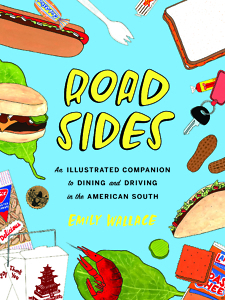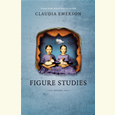One for the Road
Emily Wallace’s Road Sides serves up a philosophy of adventurous eating and exploration.
You could argue that many of us modern-day roadtrippers have lost our ability to explore. Blinkered by “Best of” lists, Google maps, and Yelp, most folks opt to drive straight to the five-star experience and are loath to take a chance on anything “less.”
 Enter Emily Wallace, an author and illustrator from North Carolina whose new road-food guide, Road Sides, seeks to remind travelers that it’s more fun to wing it. Wallace is art director and deputy editor of Southern Cultures quarterly, and she once wrote a master’s thesis on pimento cheese, so she probably has a hundred “Best of” lists in her head. But she refuses to rob readers of the joy of finding those joints themselves.
Enter Emily Wallace, an author and illustrator from North Carolina whose new road-food guide, Road Sides, seeks to remind travelers that it’s more fun to wing it. Wallace is art director and deputy editor of Southern Cultures quarterly, and she once wrote a master’s thesis on pimento cheese, so she probably has a hundred “Best of” lists in her head. But she refuses to rob readers of the joy of finding those joints themselves.
Instead, Wallace’s guide is a series of playful A-to-Z musings on Southern folklore and history, from food-shaped architecture to odd theme parks. And although the articles may prompt readers to visit a few specific attractions, Wallace’s aim is to inspire something deeper: a curious wanderer’s mindset that values journey over destination.
Wallace recently answered questions from Chapter 16 by email:
Chapter 16: You’ve called Road Sides an “illustrated glovebox essential.” How do you imagine people using it?
Emily Wallace: Road Sides will fit into a glovebox (unless your glovebox is full of old CDs, like mine). But I envisioned it more as a handbook to the experience of eating on the road, rather than a guide to specific locations. There are plenty of maps and apps for that. So I really tried to focus on the why instead of the where — for instance, why food-shaped buildings exist, but not necessarily where to find the best examples (though the snow cone-shaped stand in my hometown, Hills of Snow, is exemplary!).
Chapter 16: Do you enter different mental/creative states when you’re writing vs. drawing?
Wallace: One process often informs the other. When writing about the history of barbecue and barbecue joints for Road Sides, I talked about how pigs are often portrayed on restaurant signs and menus adorned in crowns and bow ties and thought, “I’d like to draw that.” So I made a painting of prestigious pigs. And for the entry on South of the Border [a campy faux-Mexican-themed attraction near the South Carolina and North Carolina border], I knew I wanted to draw the neon fiberglass animal statues that dot the park, so I set out to write about them, too. Writing is in some ways a slow way for me to brainstorm my art, and drawing is a meditative way for me to think about my writing.
Chapter 16: You’ve organized the book as a kind of A-to-Z primer where every letter represents the subject of an article, like B for Billboards or M for Meat-and Threes. How did you decide to organize it this way?
Wallace: I wanted to create a book that was part travel guide, describing particular places, and part encyclopedia, with historical entries to give context to those places. So an A-to-Z structure seemed like an obvious way for people to quickly dive in and look up the restaurants or concepts. But I was also influenced by a great book named Quodlibet. Illustrated by Katja Spitzer and written by Sebastian Gievert, Quodlibet is an encyclopedic ode to the letter Q, defining lesser-known Q words alongside some wacky illustrations. There’s an element of surprise throughout the book that I really like — from the words themselves to the details in the definitions and drawings. And that’s something I tried to do with Road Sides. I included some obvious and necessary entries for a book on road culture (C for Car, D for Directions), but I attempted to fill them with surprising information, or to pair them against unexpected aspects of road-related travel and dining, too (H for Hyperbole, J for Junque).
Chapter 16: Was there a letter you had to stretch pretty far to find a category for?
Wallace: X was definitely up there on the list. But I found K to be particularly difficult to pair with a concept. I spent a lot of time thumbing through the K section of dictionaries at the library and on Scrabble websites, to no avail. I eventually settled on K for Kudzu as a bit of a cop-out, thinking that you can’t drive through parts of the South without seeing large swaths of the invasive plant draped over trees and telephone poles. But Kudzu turned out to be one of my favorite entries. In the heyday of road building, kudzu was planted as a means to shore up shaky soil where roads had been cut into the land. The vine grew fast and basically acted as a natural net to hold loose dirt in place. And kudzu is edible. Blossoms are often steeped to make jellies and teas that are sold by the roadside in some parts of the South.
More importantly, kudzu introduced me to Edith Edwards, one of my favorite people I interviewed for the book. Edwards lives in Rutherfordton, North Carolina, where, in her 90s, she reigns as the self-proclaimed Kudzu Queen. She deep fries kudzu leaves, steeps blossoms for jellies, and dries the vine to make baskets. Along with her late husband Henry, she also used to bale the vine like hay to feed to cattle. (Her son Duncan now does that.) Edwards made me look at kudzu in a completely different light, and since it’s everywhere, I do that often.
 Chapter 16: At first glance, this is an upbeat, breezy book about road food and wacky roadside attractions, with scholarship and folklore sprinkled in. But you touch on darker themes, too, like Jim Crow and Confederate monuments. Do you think Southerners — and travelers headed South — are willing to hear the complicated history of this region, or do they crave a whitewashed, mythologized version?
Chapter 16: At first glance, this is an upbeat, breezy book about road food and wacky roadside attractions, with scholarship and folklore sprinkled in. But you touch on darker themes, too, like Jim Crow and Confederate monuments. Do you think Southerners — and travelers headed South — are willing to hear the complicated history of this region, or do they crave a whitewashed, mythologized version?
Wallace: By day I work as the art director and deputy editor of Southern Cultures, a peer-reviewed journal housed at the Center for the Study of the American South [at the University of North Caroline at Chapel Hill]. We have readers in more than 120 countries who subscribe to the journal or access articles online. For me, that’s a daily reminder that many Southerners and beyond are looking for deep scholarship on the South, and want to reckon with hard truths and histories.
Chapter 16: We longtime Southerners are always talking about disappeared and endangered things, like bustling small-town Main Streets, bizarro theme parks, and rural mom-and-pop stores. As you drive Southern back roads, do you believe some of that unpolished weirdness can survive big-box and fast-food chain culture?
Wallace: Obviously, many mom-and-pop places have shuttered against big budget chains or interstates that completely pass them by. But there are also a lot of places that have held on and will continue to do so with wit and grit, and maybe some luck. There’s also been renewed interest in local spots. Culinary tourism is big business, and people seem increasingly willing to drive out of their way to taste a town’s signature dish or to experience something out of the ordinary, rather than stopping at a ubiquitous chain restaurant or hotel.
When it comes to hotels, it’s evident how many places are also drawing on the past to capture a present audience. More and more, “retro” motels are opening or renovating, billing themselves as unique or boutique experiences compared to, say, a Holiday Inn. And just as motels emphasized at their height during the mid-20th century, these revamped lodgings tout affordability with key amenities. Take Nashville’s new Dive Motel + Swim Club. Originally opened as the Key Hotel Motor Inn in 1956, the Dive offers a swimming pool, a hip wood-paneled bar, late-night dining, and vintage décor, all for around $150 a night. In some ways, it’s “bizarro” for a new generation.
Chapter 16: It’s my understanding you’re a pimento cheese scholar. Can you tell us something fascinating about p. cheese that we didn’t know?
Wallace: I wrote my master’s thesis on the social history of pimento cheese. Part of studying the spread involved breaking it down and looking at its primary ingredients—cheese, mayonnaise, and pimiento peppers. The latter took me to Johnson City, Tennessee, which is the headquarters of Moody Dunbar, now the largest pimiento packer in the nation.
The pimiento — a small, heart-shaped red pepper that tends to be ignored — was imported from Spain until around 1908, making it (and subsequently, pimento cheese) a delicacy. But some ten years later, the pepper was being grown across fields in Georgia as a way to diversify against King Cotton. Pimientos became a major crop. Pimiento-themed parades were held in small towns, pimiento queens were crowned at festivals, and pimiento factories opened in other parts of the South, including Tennessee. Today, most pimientos are grown outside of the South in states like California. But I think the little-known pepper’s prominence in the region at one time helped cement pimento cheese’s fate as a Southern staple.

Kim Green is a Nashville writer and public-radio producer, a licensed pilot and flight instructor, and the editor of PursuitMag, a magazine for private investigators.





